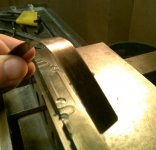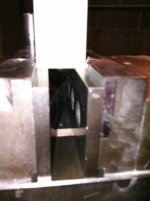QuickFab
Plastic
- Joined
- Jan 5, 2014
- Location
- Middletown, R.I. U.S.A
I watched a ton of youtube vids with people having to remove their parallel bars after each cut because the chips get under them.
Also the parallel bars are tipping over, I have no idea how your parts come out square???
There is such a simpe solution to this problem and it costs absolutely nothing.
All you need is some of that lovely metal straping they use when shipping heavy boxes. you could probably use just about any type of flexible metal, maybe even some old regular broken bandsaw blades could do, just grind down the teeth.
These things can be bent into any shape or size you need. Make into a giant horseshoe shape with feet for larger items too.
you can also use them with just one bar if the part is real small.
I even have used three of them to keep the bars floating in the middle of the vise (vise - strap - parallel - strap - parallel - strap - vise).
You don't have to use them with just parallel bars either. stick them in their with 123's to take up space with a part that is bigger then the 123's.
Just use your imagination.
I love little things like this that make working easier.
Here is a few pics so you can visually see what I am refering to.





And by the way, I did not put all those holes in the vise. I am only responsible for 3 of them and two of them wasn't really my fault cause the stupid machine kept jumping .020 on the Z axis due to the knee cover plates binding up under each other. that vise has seen over 10 years of service.
Anyways try this out and don't forget to round off the corners and make them dull or you'll be sorry!
One more note: If you seat the part, then brush or vacuum it off, then hit it with some compressed air BEFORE remove the part you will be able to remove almost all the chips out, then remove the part and hit it with some air again, just remember your safety glasses.
Also the parallel bars are tipping over, I have no idea how your parts come out square???
There is such a simpe solution to this problem and it costs absolutely nothing.
All you need is some of that lovely metal straping they use when shipping heavy boxes. you could probably use just about any type of flexible metal, maybe even some old regular broken bandsaw blades could do, just grind down the teeth.
These things can be bent into any shape or size you need. Make into a giant horseshoe shape with feet for larger items too.
you can also use them with just one bar if the part is real small.
I even have used three of them to keep the bars floating in the middle of the vise (vise - strap - parallel - strap - parallel - strap - vise).
You don't have to use them with just parallel bars either. stick them in their with 123's to take up space with a part that is bigger then the 123's.
Just use your imagination.
I love little things like this that make working easier.
Here is a few pics so you can visually see what I am refering to.





And by the way, I did not put all those holes in the vise. I am only responsible for 3 of them and two of them wasn't really my fault cause the stupid machine kept jumping .020 on the Z axis due to the knee cover plates binding up under each other. that vise has seen over 10 years of service.
Anyways try this out and don't forget to round off the corners and make them dull or you'll be sorry!

One more note: If you seat the part, then brush or vacuum it off, then hit it with some compressed air BEFORE remove the part you will be able to remove almost all the chips out, then remove the part and hit it with some air again, just remember your safety glasses.





